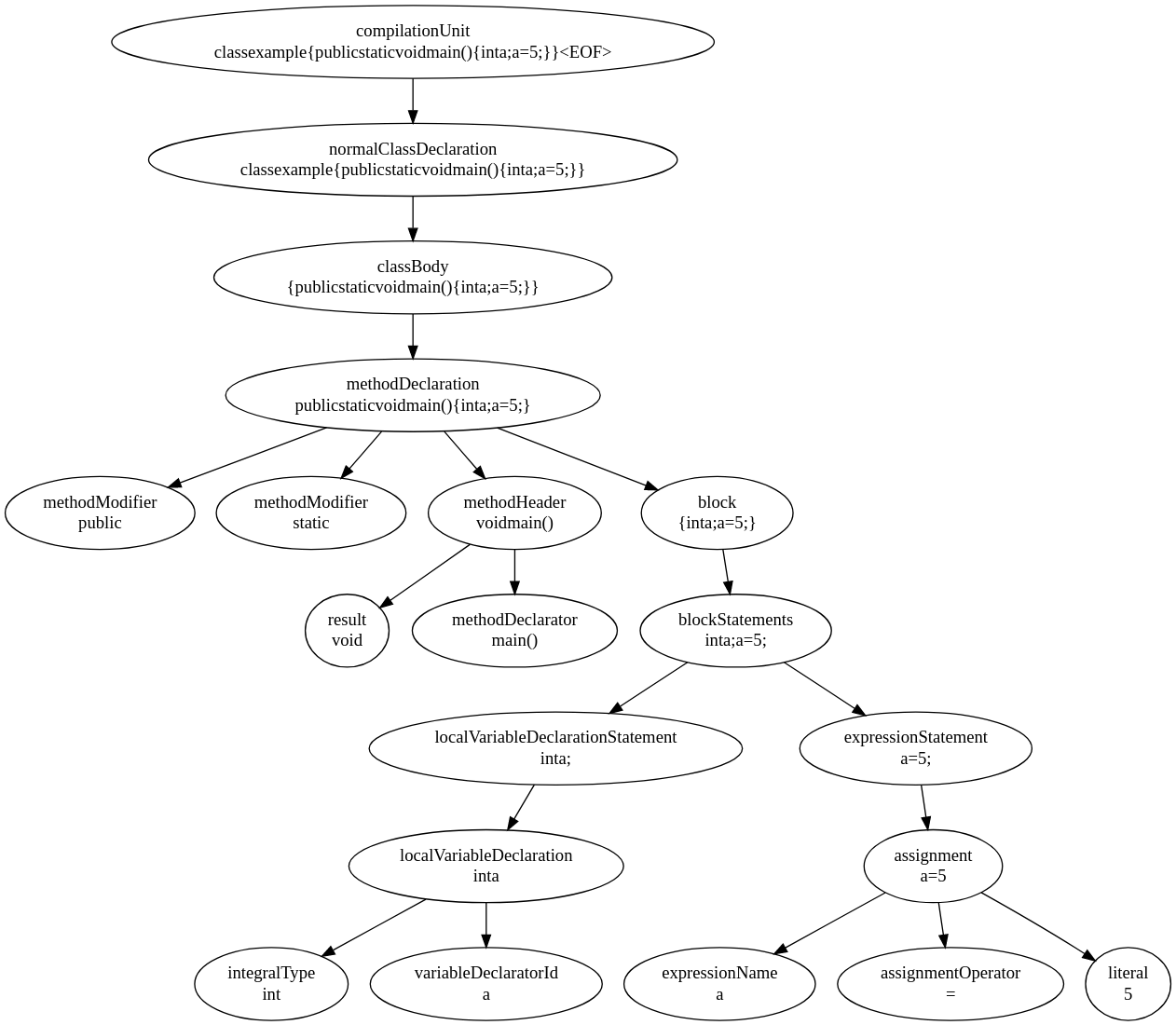I am working with ANTLR4 to generate AST of a java source code and i had to move to ANTLR3 because i was not getting much help and documentation and it was really tough to proceed.I managed to generate AST but not in a visual format. Then i came across an awesome answer and i was really able to generate AST in a DOT file but there was a slight problem.
My code:
import org.antlr.runtime.CommonTokenStream;
import org.antlr.runtime.ANTLRFileStream;
import org.antlr.runtime.tree.CommonTree;
import org.antlr.runtime.tree.DOTTreeGenerator;
import org.antlr.stringtemplate.StringTemplate;
class Main {
public static void main(String[] args) throws Exception {
parseFile("/home/satnam-sandhu/Workstation/ASTGenerator/resource/java/Blabla.java");
}
public static void parseFile(String f)throws Exception {
JavaLexer lexer = new JavaLexer(new ANTLRFileStream(f));
CommonTokenStream tokens = new CommonTokenStream(lexer);
JavaParser parser = new JavaParser(tokens);
CommonTree tree = (CommonTree)parser.compilationUnit().getTree();
DOTTreeGenerator gen = new DOTTreeGenerator();
StringTemplate st = gen.toDOT(tree);
System.out.println(st);
}
}
I am using gradle so i build the project by:
gradle clean build
And then run it and pipe the output to a dot file by:
java -jar ASTGenerator.jar > ast.dot
Now the issue i am facing is that, for a source code of:
class example{
public static void print(int a){
int b = a +1;
System.out.println(b);
}
public static void main(){
print(15);
}
}
I am getting this as the output:
digraph {
ordering=out;
ranksep=.4;
bgcolor="lightgrey"; node [shape=box, fixedsize=false, fontsize=12, fontname="Helvetica-bold", fontcolor="blue"
width=.25, height=.25, color="black", fillcolor="white", style="filled, solid, bold"];
edge [arrowsize=.5, color="black", style="bold"]
n0 [label=""];
n1 [label="class"];
n2 [label="example"];
n3 [label="{"];
n4 [label="public"];
n5 [label="static"];
n6 [label="void"];
n7 [label="print"];
n8 [label="("];
n9 [label="int"];
n10 [label="a"];
n11 [label=")"];
n12 [label="{"];
n13 [label="int"];
n14 [label="b"];
n15 [label="="];
n16 [label="a"];
n17 [label="+"];
n18 [label="1"];
n19 [label=";"];
n20 [label="System"];
n21 [label="."];
n22 [label="out"];
n23 [label="."];
n24 [label="println"];
n25 [label="("];
n26 [label="b"];
n27 [label=")"];
n28 [label=";"];
n29 [label="}"];
n30 [label="public"];
n31 [label="static"];
n32 [label="void"];
n33 [label="main"];
n34 [label="("];
n35 [label=")"];
n36 [label="{"];
n37 [label="print"];
n38 [label="("];
n39 [label="15"];
n40 [label=")"];
n41 [label=";"];
n42 [label="}"];
n43 [label="}"];
n0 -> n1 // "" -> "class"
n0 -> n2 // "" -> "example"
n0 -> n3 // "" -> "{"
n0 -> n4 // "" -> "public"
n0 -> n5 // "" -> "static"
n0 -> n6 // "" -> "void"
n0 -> n7 // "" -> "print"
n0 -> n8 // "" -> "("
n0 -> n9 // "" -> "int"
n0 -> n10 // "" -> "a"
n0 -> n11 // "" -> ")"
n0 -> n12 // "" -> "{"
n0 -> n13 // "" -> "int"
n0 -> n14 // "" -> "b"
n0 -> n15 // "" -> "="
n0 -> n16 // "" -> "a"
n0 -> n17 // "" -> "+"
n0 -> n18 // "" -> "1"
n0 -> n19 // "" -> ";"
n0 -> n20 // "" -> "System"
n0 -> n21 // "" -> "."
n0 -> n22 // "" -> "out"
n0 -> n23 // "" -> "."
n0 -> n24 // "" -> "println"
n0 -> n25 // "" -> "("
n0 -> n26 // "" -> "b"
n0 -> n27 // "" -> ")"
n0 -> n28 // "" -> ";"
n0 -> n29 // "" -> "}"
n0 -> n30 // "" -> "public"
n0 -> n31 // "" -> "static"
n0 -> n32 // "" -> "void"
n0 -> n33 // "" -> "main"
n0 -> n34 // "" -> "("
n0 -> n35 // "" -> ")"
n0 -> n36 // "" -> "{"
n0 -> n37 // "" -> "print"
n0 -> n38 // "" -> "("
n0 -> n39 // "" -> "15"
n0 -> n40 // "" -> ")"
n0 -> n41 // "" -> ";"
n0 -> n42 // "" -> "}"
n0 -> n43 // "" -> "}"
}
When using http://viz-js.com/ for visualising the output is like this:

All my work till now is uploaded here if you guys feel like to dig deeper into the grammar file i am using. I think options specified in the grammar file can also be the reason. I am a beginner cannot proceed without a little help. Thanks in advance. :)


Java.gfile as shown in this Q&A: #4931846 – Vacla